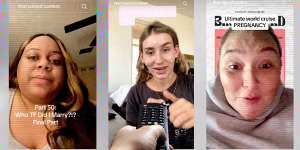Scandalous,shocking,it’s everything you’d want from reality TV,yet,it isn’t a reality show. Teesa told her story via a 50-part TikTok series entitledWho TF Did I Marry?.

TikTok is filled with reality content that puts even the most popular TV shows to the test. Reesa Teesa,left,has captivated millions of viewers.Compiled by Nathan Perri
Adopting a simple vlog style,Teesa explains how she met her ex-husband – who she gives the pseudonym Legion – right on the cusp of COVID-19 lockdowns in her home state of Georgia,all the way to their messy divorce about two years later. Throughout,she unravels Legion’s intricate web of alleged lies,including his job,bank statements,family deaths,and a fabricated trip to London.
A TikTok user has since uploaded a series of videos denying Teesa’s accusations,posting clips that allegedly show and screenshots of correspondence between him and Teesa. According toTMZ,he met with attorneys earlier this week to against Teesa;however,no action has been confirmed. In fact,several people have claimed to be Legion since Teesa’s series aired.
Teesa’s videos are nine to 10 minutes long and the series takes just short of eight hours to complete. The entire series has attracted over 335 million views,including individual viewers watching all 50 parts. To put its popularity into perspective,the first reunion episode for season 10 ofVanderpump Rules,which was rocked by the,reached in May. This was US network Bravo’s most-watched episode of any reality series in over nine years,yet the ofWho TF Did I Marry?attracted more than double this amount (10.3 million views).

Other TikTok series exploring real-life drama have also enjoyed success,albeit not to the extent of Teesa’s. “”,which documents the experiences of passengers aboard the Royal Caribbean’s nine-month world cruise,has generated over 400 million views since December,and videos,which lay bare the highs and lows of real-world dating,have generated 7.3 billion views. Notably,various content creators contribute to these series.
Much of the success of reality content on TikTok comes down to shifts in the way we consume media,says Suzie Shaw,chief executive of creative agency We Are Social. “We’ve become programmed to this high frequency,high content volume life … Whatever is presented in a bite-sized,snackable,easily understood way,that’s the new era of successful media.”
On TikTok,one need only swipe to get the next dopamine hit – and short video lengths make it an ideal platform for “binge-viewing”,something reality shows strive for.
“They keep thinking,‘what’s one more 10-minute video? That’s not a big commitment’,” Shaw says.
According to We Are Social’s,Australian Android users (between 16 and 64) spent more time on TikTok than any other social media platform in 2023,clocking an average of about 1.5 hours per day.

The report revealed a marked decline in traditional media usage,including a 15 per cent decrease in time spent watching broadcast and streaming television.
“Everyone’s got a mobile in their pocket. Traditional media is not so readily available,” Shaw says. “It’s also generally less interactive or engaging than social media. Wanting to connect with others is a fundamental human driver.”
Alisha Aitken-Radburn,formerBachelor contestant and author ofThe Villain Edit,says this interactivity can also lead to longer-term engagement.
“The story doesn’t stop with the storyteller. Teesa’s audience has already hunted down the antagonist of her story. They’re even finding side characters like her real estate agent,or Legion’s ex-wife,and looking for them to share their perspective,” she says.
“It’s hard for traditional media to compete with the depth and nuance of storytelling offered on social media and key to traditional reality TV’s success currently is the drama extending off-screen.”
The democratic nature of TikTok means any creator can share their story,rather than just a carefully selected cast,which Shaw says increases its relatability.
“Traditional media has many gatekeepers,whether it’s the publisher,the network boss,or whoever. They determine the faces and voices you’ll see,hear and engage with,” Shaw says. “Social media has taken away those gatekeepers.”
Shaw says TikTok is also global,unlike some reality shows bound by a geographical location.

MAFS Australia airs on free-to-air Channel 9. Meanwhile,Reesa Teesa’s series reached TikTok users across the globe immediately upon release.Nine
Dr Daniel Binns,a film and media lecturer at RMIT who also worked on the boxing reality showMaximus Academy,says content like Teesa’s could offer a refreshing dose of authenticity to audiences who may be tired of hyper-produced reality shows.
“TikToks often look as though they’re filmed much more casually,like the creator picked up their phone on a whim to share what’s going on. That sense of immediacy lends itself very well to real stories,” Binns says.
“It dovetails in with post-truth politics,concerns over fake news and so on. These are all symptoms of the modern media age.”
Aitken-Radburn says most viewers are savvy enough to recognise when a reality show has been edited to suit a certain narrative,and often avoid content deemed inauthentic.
“We’re past the black-and-white characterisation of baddies and goodies. We want to understand the people in the stories we consume,and we increasingly value depth and nuance in those stories.”
Authentic content also benefits the creator,Binns says. Teesa’s direct-to-camera,made-for-mobile series would have been extremely low-cost,while ripe for monetising. Currently,creators in the US,UK,Spain,Germany,Italy and France have access to TikTok’s,which enables successful videos to turn a profit.
We could therefore see more people attempting to jump on the TikTok reality bandwagon;however,Binns notes going viral is far from straightforward.
“Virality is a sort of unattainable,almost romantic,mystical thing,” he says. “TikTok is a huge platform,and it’s very protective over how things go boom. It’s dependent on so many factors.”
And regular reality TV is still going strong,Binns adds,with shows likeLove Is Blind and.
Regardless,Shaw is confident reality content will continue to grow on TikTok,perhaps even eventually encouraging traditional broadcasters to adopt its algorithmic,short-form structure.
“I think Teesa could be a bit of a catalyst,” she says. “Traditional broadcasters may start to consider what the TikTok-ification of their content would look like … It seems like a no-brainer to me.”
Find out the next TV,streaming series and movies to add to your must-sees..
